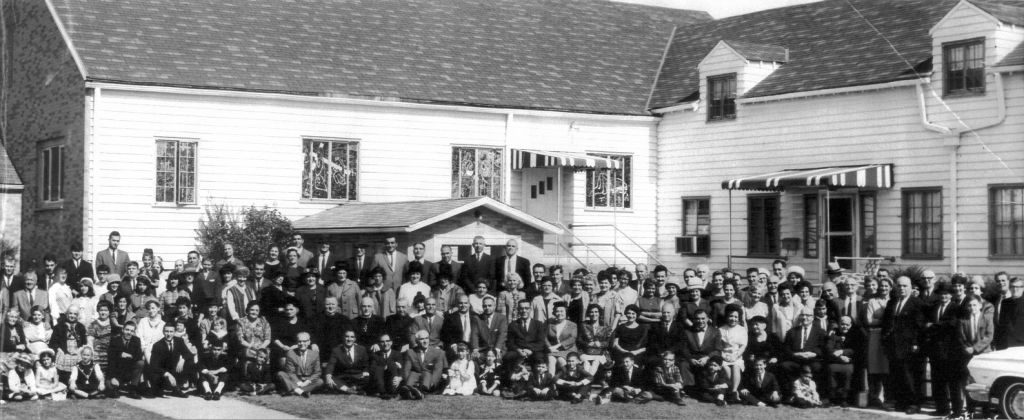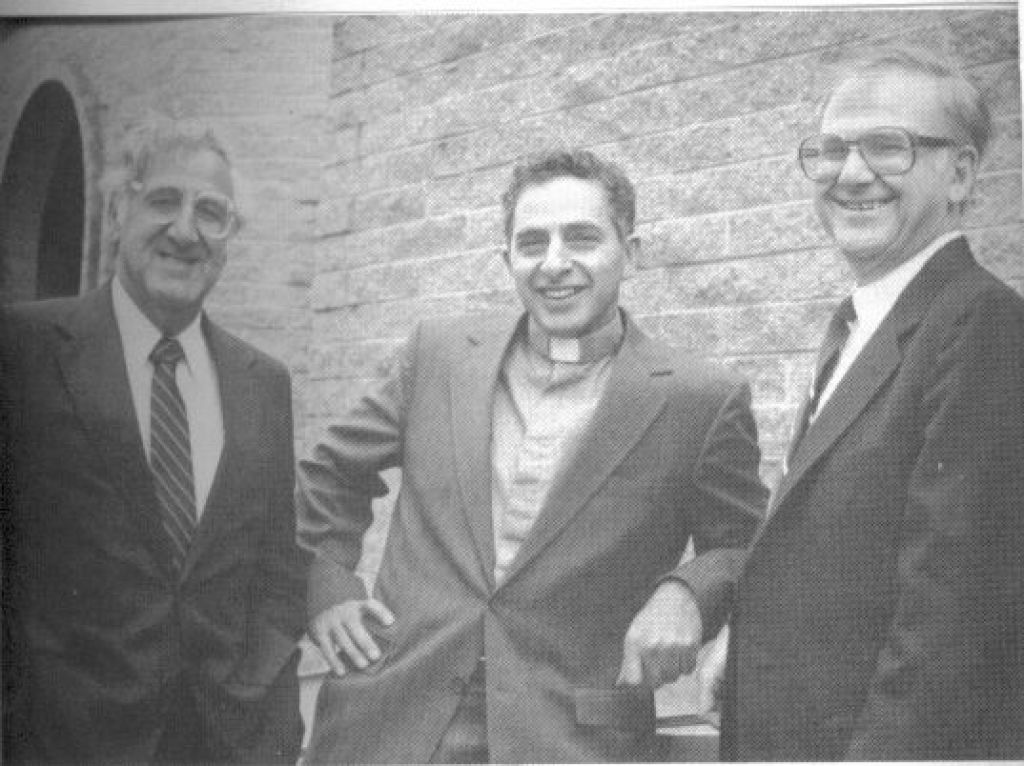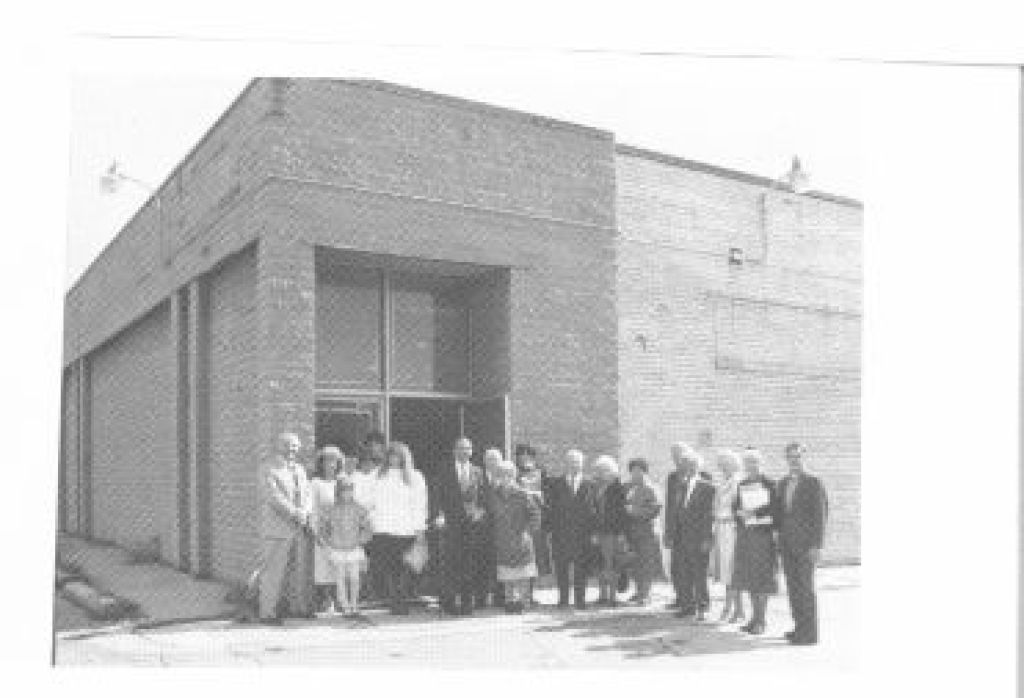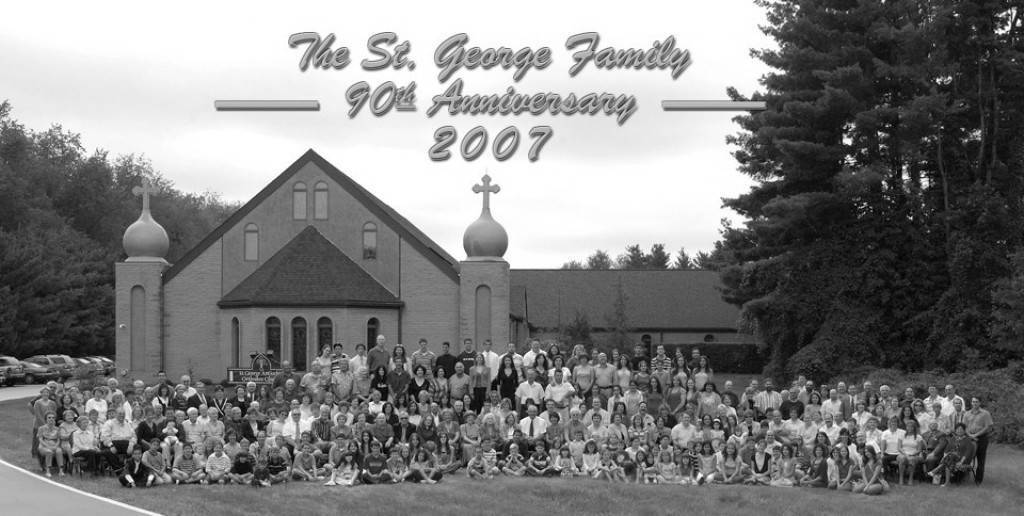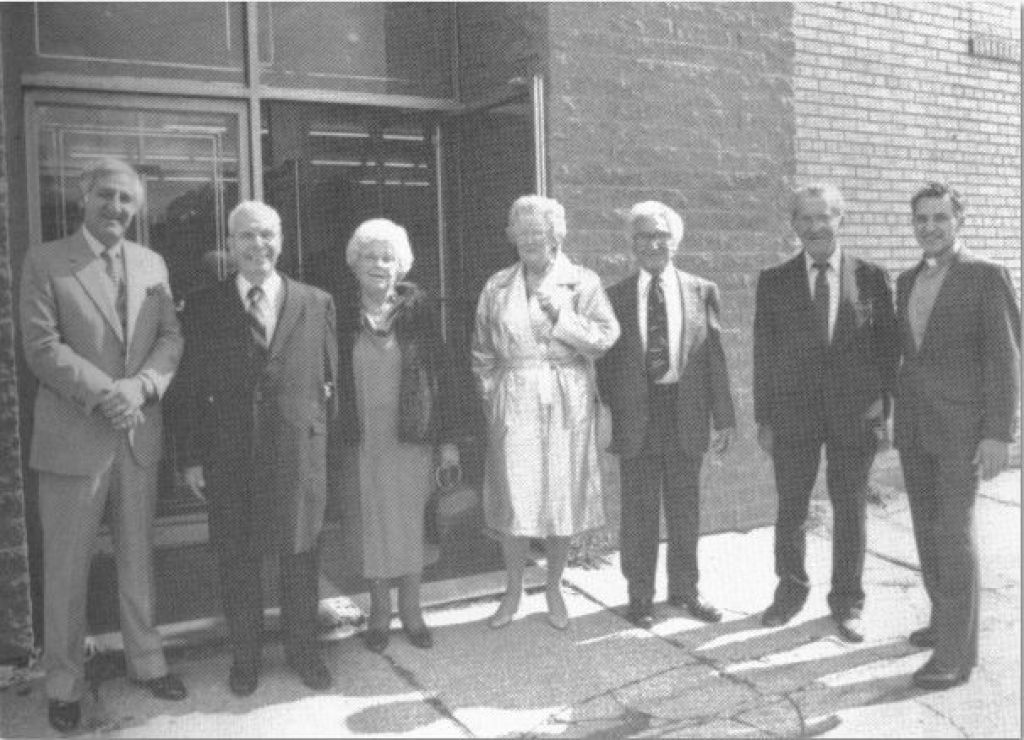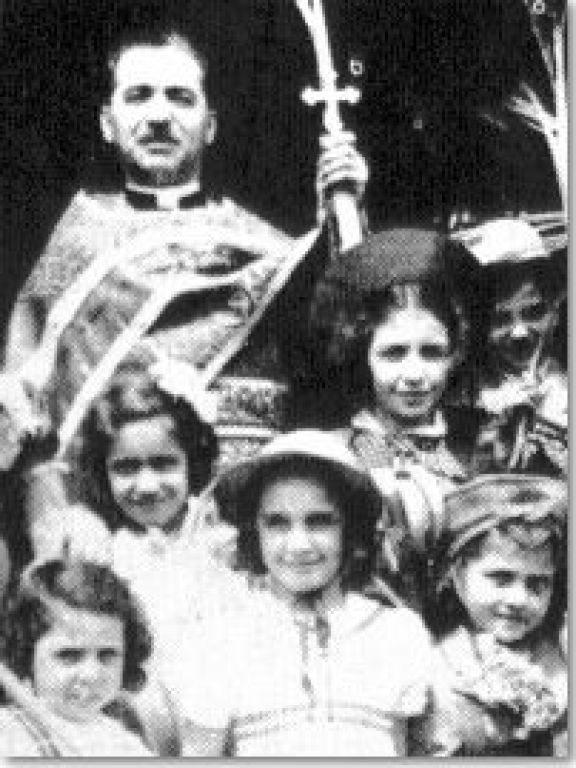History
St. George Akron History
At the end of the 19th Century, thousands of immigrants came to the United States from eastern and southern Europe. Included with those immigrants were a small group of Arabic-speaking Christians from the Holy Lands of the Middle East. They came from modern day Lebanon, Syria, Palestine, and Jordan. Their homeland was the cradle of civilization, as well as the birthplace of the Christian, Jewish and Moslem faiths.
These Arabic-speaking Christians were Eastern Orthodox, Melkite Catholics, and Maronite Catholics. They were of different denominations bound together by the ecumenism and cultural closeness that characterized the Christian minorities of the Middle East. They were determined to continue their age-old faith traditions in the new American home.
In those early days, there were not enough of any group to start their own church. Therefore, whenever an itinerate clergyman came to the area — whether Orthodox, Maronite, or Melkite — all the people would assemble in a home or a hall to worship together. It was not unusual for Orthodox children to be baptized by Melkite or Maronite priests. Nor was it unusual for a Melkite couple to be married by an Orthodox priest.
In time as more settlers and immigrants arrived, families multiplied and grew. Each group was able to establish its own church: St. George Orthodox Church, St. Joseph Melkite Catholic, and Our Lady of the Cedars of Lebanon Maronite Catholic. All three churches still exist in Akron.
Challenge of Getting Started
Since its beginning, Akron’s St. George has been faced with a series of challenges. The greatest challenge was getting started. The Orthodox population was quite small and scattered around the area. In addition, wages were low, and responsibilities were high. Each family head had to provide for large and growing families and providing money to bring other family members to America. There was little money left to build a church.
The challenge was great, but these early immigrants had two strengths in their favor:
Firstly, they were strengthened by their bonds to the ancient Orthodox Church of Antioch, “where the disciples were first called Christians.” The Antiochian Church had managed to survive despite repeated wars, invasions, persecutions and pestilence. Surely, the Akron Antiochian Orthodox people could continue this tradition in America.
Secondly, the Akronites were blessed to enjoy the leadership of Father George Kattouf. This dedicated priest, who lived to become a legend in his own time, came to Akron in 1916. He had already established churches in Wilkes0Barre, Pa. and Charleston W. VA. He organized the Akron Orthodox people into a parish, traveling from city to city, raising funds to get the Akron church started.
Thanks largely to Father Kattouf’s efforts -- and the sacrifices of the early Antiochian Orthodox settlers – it was possible to construct the original St. George Church building at Water and Chestnut Streets near downtown Akron. The articles of incorporation, dated September 12, 1917, were signed by Father Kattouf, Michael Curi, Elias Salhany, Essa Salhany, and George Thomas.
Six months after chartering St. George Antiochian Church of Akron in September of 1917, the Great Flu Pandemic of 1918 broke out as the American Armed Forces entered WWI. Because of the Allies blockade of the Ottoman Empire, contact with relatives in the Levant were cut off. The blockade resulted in starvation throughout the Middle East. Compounding the suffering were various plagues culminating in Great Flu Pandemic. Thousands died of starvation and plague. Following the conclusion of the Great War, a tremendous wave of immigration came from the Middle East to America and to the church of Akron St. George.
Father Kattouf continued to serve the Akron parish until 1925, when he was called to Altoona, Pa. where he established a fourth church in America. There was great mourning when he passed away in 1956. Father Spyradon Massouh frequently helped Father Kattouf serve the Akron Parish. After Father Kattouf left Akron St. George, he was followed by various priests from 1926 to 1937, including Fathers Elias Alhawy, Michael Deebeh, Ribany, Elias Hamaty, and John Khoury.
Challenge of Survival
The challenge of getting started was no less imposing the challenge of surviving and keeping the church doors open. There was a mortgage. There were lingering problems of too few people and too little resources. Following WWI, and the Great Pandemic, the American public reacted strongly to the new influx of immigration from the Middle East and Eastern and South Eastern Europe. The KKK reached the height of its influence in America as a political force. Laws were passed restricting immigrations and setting up quotas based on national origin. It was called the Immigration Act of 1924. Within a few years, the nation would undergo the Great Depression. Yet by the grace of God and sheer determination, the people overcame all obstacles. In 1935, despite all the hardships of depression, the parishioners of St. George Akron were able to pay off the initial mortgage.
The church’s earliest chanter was Gabriel Salhany, one of the lay founders who was later ordained into the priesthood and served Antiochian Orthodox parishes throughout the country. Other early chanters included Thomas Ferris, another founder and John Jacob. Sam Jacob came to Akron shortly after 1935 and served as chanter for thirty years.
In the mid-30’s Selma Haddad, wife of church founder Elias Eid Haddad, became the first woman chanter at Akron St. George. Other women chanters throughout the years include Alice Elias, Kim Shama Hanna, Nancy Stevens, Martha George and Khouriyee Mira Corbin.
The Late 1930’s and World War II
In 1937 Father Solomon Razook came to Akron St. George and stayed for six years. A devout, gentle and kindly man, Father Razook endeared himself with all the parishioners. He loved children, and they loved him.
Came World War II and the Akron St. George parishioners joined their fellow Americans against the Axis Powers. Many of the church’s young men were already in uniform when Pearl Harbor was bombed on December 7, 1941, and they were among the first to go overseas and enter the battle. Every family sent sons or daughters to the Armed Services, including three sons of Father and Mother Razook. On the home front, men and women, young and old worked in the factories, served in civil defense, gave blood. Bought and sold war bonds, helped the Red Cross, and in many ways contributed to the great victory.
Father Razook was succeeded during the war years by Father E.S. Hamaty, who served from 1943 until his death in early 1945. He was followed by father Elias N. Ellis, who served the parish throughout most of 1945, while the country was still at war. This was a difficult time Father and his Khouiyee; one of their sons was killed in action while serving the U.S. Navy in the Pacific. Father Ellis also served Akron St. George from 1951 until his death late in 1953.
Challenge of Transition
It was during the war that Akron St. George came to grips with the new challenge that emerged: the challenge of transition.
Since Akron St. George had been established by Arabic-speaking peoples, it was logical that Arabic continued to be the language of the church during the first two decades. However, a problem was posed by the emergence of second and third generation Americans. They were born and reared in this country. They were Americans in language, culture and tradition. How could the Antiochian Church satisfy the religious hunger of her youth, most of whom could not understand the classical, formal Arabic used in the liturgies and sermons?
Fortunately, the church’s spiritual leader – The Most Reverend Metropolitan Archbishop Antony Bashir – had readied his churches throughout North America for this hour of transition. Under his guidance, English versions of the liturgies, services, choir music, educational materials were prepared. He made plans for Sunday School and youth groups, and he began the schooling of American-born young men for the priesthood.
Thus, the Akron parish, along with others throughout the North American Antiochian Archdiocese, was able to begin the gradual transition to the American scene. In the 1940’s Father Ellis became the first priest in Akron to use English in both the liturgies and the sermon. During this time of transition, John Elias was the perennial church trustee and president. He and his wife Louise – as the founder of the Sunday School – played a critical role in the transition.
John was the leading lay leader when Fr. Elias N. Ellis began using English at St. George in 1944, and when this trend was continued and expanded by Fr. George Simon and FR. Nicholas Kobbs. Louise stepped into the picture when Fr. Ellis asked her to start the Sunday School. She taught Sunday School for 20 years and played a key role in developing lessons and literature, and in training teachers. She even enlisted her son Ritchie – then only 14 years old – as a teacher. From that beginning we have grown to a Sunday School program, under Julia Shaheen, which today has nearly 12 teachers serving nearly 100 children. This is truly a remarkable achievement.
Father George Simon, who served the parish from 1946 to 1951, was born in Lebanon, and Arabic continued to be his major language. Nonetheless, he had the foresight to recognize the church had to Americanize. Under his distinguished leadership, headway was made establishing an all-English choir, Sunday Schools, and a local chapter of the Society of Orthodox Youth Organizations (SOYO). He also instituted the envelope pledge system, and in many ways contributed significantly to the challenge of transition.
Challenge of Expansion
Thus, Akron St. George was well on the road toward Americanization when Father Nicholas N. Kobbs came to Akron in 1954. Of Russian descent, he was the first American born priest to serve Akron St. George and the first who did not have an Arabic-speaking background.
Father Kobbs completed the Americanization of Akron St. George. But now a new challenge loomed forth – the lack of space. How could the tiny church facility near down-town Akron continue to house a growing parish and accommodate the diversified religious, educational and fellowship programs?
Just as Father Kattouf had taken the lead funding the church, now Father Kobbs took the lead in expanding it. Called the “Whirl-wind Priest” by an Akron Beacon Journal columnist, Father Kobbs with his familiar “God love ya” -- rallied together all the parishioners and inspired them to rise to the new challenge. They sought new avenues of support. They took on hosting the 1956 Midwest Region SOYO Convention. Although the Akron parish was the smallest to assume this responsibility, the members staged a convention that long held the all-time record for attendance. Father Kobbs was also instrumental in obtaining official recognition of Eastern Orthodoxy as the fourth major faith in Ohio.
Late in 1956 expansion became a reality. After thirty-nine years in the original church building, the parish moved to a location at 1007 South Hawkins Avenue. The new facilities included a church, fellowship-education hall, ten-room parsonage, and parking area.
New Wave of Members
As we have seen, Akron St. George was founded by Arabic-speaking Antiochian Orthodox Christians from the Middle-East. These founders and their descendants made up most of the church membership during the 1930’s and 1940’s, although they were joined by members of the same ethnic background arriving from other cities and occasionally from the Middle East. New non-Arabic speaking members came to us through marriage.
But following the second World War, there was a new wave of newcomers to Akron St. George – some from Lebanon and Syria, but to a greater degree from Palestine and Jordan. In addition, members have come to us from widely diverse ethnic backgrounds and Christian denominations. These newcomers in Akron breathed new life into our church. They have become strong supporters and assumed positions of leadership in church organizations. Akron St. George has proudly maintained its Arabic Antiochian roots, and the Arabic chanting is still done, but English has long been the major language.
In time the impact of this new wave became apparent. This can be seen by forging ahead in this story and citing several examples:<> When we observed our 70th Anniversary in 1987, the chairman of Parish Council was Dr. Nabil Manneh, from Palestine <> His wife Mae headed the St. George Antiochian Women’s Chapter at our 90th Anniversary <> members of the Halasa, Zawahri, Qaqish, and Kakish families have long served on parish council.
Fiftieth Anniversary
Under Fr. Kobbs able leadership, it was possible to burn the mortgage in 1961. By then, the church boasted a newly constructed belfry steeple, an electric carillon system, and various surrounding properties, plus money in the bank and no debt.
The Father Kobbs years were highlighted in the fall of 1967 when St. George marked its Fiftieth Anniversary with a three-day commemoration. Singled out for special honors were George Mallo, George Goson, and George Joseph, who at the time were the church’s oldest lay founders.
Guest of honor was the Most Reverend Philip Saliba, who in 1966 had been named Metropolitan Archbishop of the Antiochian Orthodox Archdiocese of North America. His presence brought much happiness.
But there was sadness too. For the Akron parish, as well as with parishes throughout the continent, still mourned the passing of Metropolitan Archbishop Antony Bashir, who headed the Archdiocese from 1936 through 1966 and was highly honored and dearly loved by all his people.
The Challenge of New Expansion
The year 1974 brought new spiritual leadership to Akron St. George – Father John N. Elias. Under the dynamic leadership of this Damascus-born priest, attendance was significantly increased as Father Elias reached out with vigor for the recent group of Antiochian Orthodox people arriving in the Akron area from the Middle East. There was a renewed spiritual awakening as church organizations were strengthened and increased financial support came from the members of the parish.
Under father Elias’ leadership, Akron St. George marked its Sixtieth Anniversary in 1977. He also planted the seeds for launching a building drive aimed at relocating the church in new and expanded facilities.
Those seeds began to grow into a mighty tree in January 1978 when Fr. Louis Mahshie assumed the spiritual leadership of Akron St. George. The first American-born priest of Arabic -speaking heritage to serve the Akron parish …. Married to the former Corinne Esber from nearby Canton, leader of the SOYO movement…. The gifted priest proceeded to earn his place, along with Fathers Kattouf and Kobbs, as a major architect of the development of Akron St. George.
Backed up by the church’s strong lay leadership “Father Lou” – as he is affectionately known began to make things happen. His first big job was to lead the parish in hosting the June 1978 Family Life Conference of Midwest SOYO. Guest of honor at this highly successful affair was Bishop Michael Shaheen. Once the Family Life Conference was over, Father Louj boldly took on the challenge of building a new church.
In 1982, after four years of careful planning, the Akron St. George parish sold its facility on South Hawkins Street, earmarked the money for the building fund, and set up temporary residence in a renovated warehouse building at 588 East Exchange Street. This building, which the parish occupied from 1982 to the end of 1987, was made available to the church without charge through the generosity of the owners, David and Helen Esber, church members and parents of Fr. Lou’s wife, Corinne.
At the same time – 1982 – an energetic building fund drive was launched. Property was purchased, and architectural plans were made. With Fr. Lou leading the way, all the St. George parishioners – men and women, young and old – pitched together, did the hard work, staged fund-raising projects, and made the great sacrifice needed to support the dream for a new church.
A special team – the A Team – was formed to lead the fund-raising effort. Under the leadership of the executive committee – made up of Bill Hanna, Henry Hanna, Frank Chema, and Mary Lou Simon-- the A Team raised nearly $1 million, which made up the key input to the drive.
Other notable fund-raising efforts were initiated by Ron Simon (the Buy a Brick Program); the annual reverse building fund raffle dinner stated by Norm Salem and John Simon Jr., and finally the 12-month raffle also stated by John Simon Jr. and Glen Wilson.
Atty. Ossie Shama worked with realtor Paul Kariotis to acquire land in the heart of Fairlawn, and then sold it for $255.000. Our current church sits on property found by Bob Snyder and negotiated by Realtor Lou Farris. Dr. Nabil Manneh was Parish Council Chairman at the time of purchase and construction.
Early in 1987, ground was broken for construction of Akron St. George at 3204 Ridgewood Road in Copley on 10 ½ acres. I was particularly appropriate that the first ground should be broken – together – by Sam Kattouf, Jacob Mallo, and John Simon Sr. They were the Church’s only three surviving lay founders from 1917-35 formative period. It was also appropriate that Ray Hanna was contracted to build the new St. George Church.
The Dream Comes True
During the weekend of November 20-22, 1987, the dream came true. The new Akron St. George Antiochian Church and fellowship Center had been built and consecrated by the late Archbishop Michael Shaheen at the same time that the church’s 70th Anniversary was observed.
General Chairman of the Consecration weekend activities was the late A.E. Shama. The son of Elias Shama, one of Akron St. George’s lay founders, Ossie was baptized in the church and a life-long member. For more than half a century he was a perennial Parish Council Chairman and trustee. He served in numerous leadership positions, and he provided legal service without fee. The long years of Ossie’s continuous, distinguished, and dedicated service singled him out as a church leader worthy of special honor.
The Challenge of the Future
Progress at St. George did not stop at 1987 when we realized our dream of a new church home. Spurred on by the dynamic leadership of Fr. Lou Mahshie, backed by his dedicated parishioners, and with the Grace of God, the church continued to forge ahead. Now enriched by an influx of members from widely diverse ethnic backgrounds, the church serves more than 200 families and maintains a Sunday School, choir, and full complement of church organizations.
Update to 2023
Here are some of the events of the years since 1987:
- Metropolitan Philip Saliba visited Akron in 1988 to elevate Fr. Lou to the dignity of Archpriest, when he marked the 25th anniversary of the priesthood and the 25th anniversary of his marriage to Khouriyee Corinne.
- St. George celebrated a mortgage burning, event in 1990, as a $550,000 debt was paid off just three years after the church was consecrated. The celebration was saddened by the passing of David Esber, a key player in making possible our new church home.
- The late Deacon Elias Meena began serving at St. George, and in 1996 he was ordained and began serving as associate pastor. He represented the third generation of Meena Orthodox priests, having been preceded by his dad, Fr. James; and his grandfather, Fr. Elias.
- Other serving clergy during Fr. Lou’s tenure as Archpriest were Fr. David Betras, Fr. Michael Corbin, and Protopresbyter Basil Shaheen.
- There was more building to come. To meet the growing needs of Akron St. George Church – particularly in the area of youth programs – Fr. Lou inspired the parish to launch a drive to construct a Family Center adjacent to the church building. With his brother-in-law David Esber chairing the drive, the $2 million facility was completed and dedicated during the weekend of April 27-29, 2012 by Metropolitan Philip and Bishop Anthony. The building was named in honor of Fr. Lou and Kh. Corinne Mahshie.
The happiness was saddened when our beloved Fr. Lou went to sleep with the Lord. Sad as this was, we were comforted to have with us Associate Pastor Fr. John Alassaf, who came to St. George in late 2009. Now under his leadership we are striking out to continue doing the work of our Lord and Savior Jesus Christ. Among other things Fr. John is spearheading efforts to open our hearts and homes to refugees who have come to us from recent conflicts and troubles in the Middle East, particularly Iraq, Syria, Lebanon and Palestine. In addition, we are receiving new members from other Christian denominations seeking their Christian roots in the most ancient of the early church patriarchates – Antioch – “where the Disciples were first called Christians.”
As we have seen over the past the past one hundred and five years, Akron St. George has managed to over-come the challenges of getting started, surviving, adapting to the American scene, expanding to new facilities, and expanding again.
Does this mark the end of tough challenges? We are well aware of the serious challenges that today confront God-fearing people throughout the world. They see in these dangers the challenges of the future – the need to re-evaluate their spiritual values, strengthen their faith, and place greater reliance on the teachings of the Church and our Lord Jesus Christ. KALLUNA SAWA – all of us together under Christ – we pledge to meet the challenges of the future.
Note: Our beloved Sam Salem is the author and gratefully acknowledges the help of Sam Kattouf and K.T. Salem in preparing the first edition of this article in 1957 (updated 1967, 1987, 2007, 2017 and 2023)

